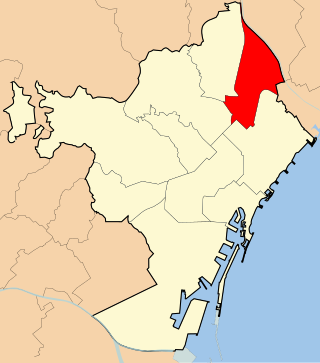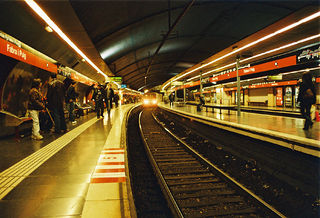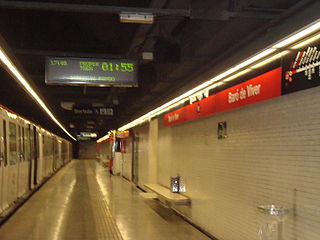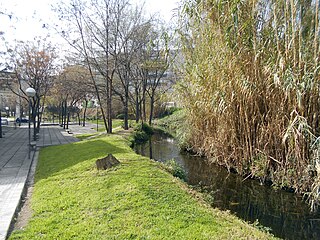
Sant Andreu is one of the ten districts of Barcelona since its redistricting in 1984. It was named after the former municipality of Sant Andreu de Palomar, which was the largest in the area and now makes up the bulk of the neighbourhood bearing its name, as well as part of the neighboring district of Nou Barris.

Plaça de les Glòries Catalanes, most often shortened to Glòries, is a large square in Barcelona, first designed by Ildefons Cerdà to serve as the city centre in his original urban plan, but nowadays relegated to quite a secondary position. It is located in the Sant Martí district, bordering Eixample, at the junction of three of the city's most important thoroughfares: Avinguda Diagonal, Avinguda Meridiana and Gran Via de les Corts Catalanes. Currently it serves largely as a roundabout of elevated highways. However, beginning in the early 2000s, and as of 2007, revamping project for Glòries has started, which is aimed to give the square a new role in Barcelona and revitalize the northern districts of the city, under the name 22@. These plans supplement other large-scale plans in Sagrera and the Fòrum area. The first installment of this project was the construction of the controversial Torre Agbar skyscraper.

Trinitat Vella is the name of a station in the Barcelona metro network, currently served by the TMB-operated L1. It's named after the neighbourhood Trinitat Vella, in the Sant Andreu district of Barcelona, and the park of the same name. It is quite unusual in being one of the few stations with an attached building overground, which lies on the Nus de la Trinitat and links the neighbourhood with Parc de la Trinitat.

Sagrera railway station is a major through station under construction in the Barcelona districts of Sant Andreu and Sant Martí, in Catalonia, Spain. It is intended to serve as the central station for northern and eastern Barcelona, with Sants serving as the central station for southern and western Barcelona. Together with El Prat de Llobregat and Sants, currently the only high-speed rail stations in the Barcelona area, it will be on the Madrid–Barcelona high-speed rail line. It will also be on the conventional Barcelona–Cerbère and Barcelona–Mataró–Maçanet-Massanes railways. Once fully completed, it will be a major public transport hub, with dedicated stations on Barcelona Metro lines 4 and 9/10, as well as a bus station. The complex will be fully underground excepting for the station building, with two levels of platforms, accounting for a total of 18 railway tracks.

Bon Pastor is a neighbourhood in Sant Andreu, a district in the city of Barcelona. Since April 2010 it's served by the Barcelona Metro station Bon Pastor.

Sant Andreu is a Rodalies de Catalunya station in the Sant Andreu district of Barcelona. It is served by Barcelona commuter rail service lines R2 and R2 Nord, as well as regional line R11. Passengers can also commute here to Barcelona Metro line 1 station Sant Andreu. It is located completely over ground.

Sant Andreu Arenal is a Rodalies de Catalunya station in the Barcelona district of Sant Andreu. It is served by Barcelona commuter rail lines R3, R4 and R7 as well as regional line R12. Passengers can also commute here to Barcelona Metro line 1 station Fabra i Puig and the Sant Andreu bus terminal. It is located where Avinguda Meridiana and Avinguda de Rio de Janeiro meet, by Rambla de Fabra i Puig.

Fabra i Puig is a Barcelona Metro station, on L1, located in the Sant Andreu district of Barcelona, below Avinguda Meridiana between Carrer de Concepció Arenal i Passeig de Fabra i Puig. It opened in 1954, with the extension of the aforementioned line from Sagrera to this station. Passengers can commute here for the Renfe-operated Sant Andreu Arenal railway station. It's named after Passeig de Fabra i Puig, one of the main thoroughfares of the area.

Torras i Bages is a station of the Barcelona Metro, on L1. Opened in 1968, it serves the northern part of the Sant Andreu de Palomar neighbourhood in the Sant Andreu district. It was one of the termini of this subway line until 1983, when it was extended into Santa Coloma de Gramenet. The station does not include accessibility facilities as of 2008. It has two 107-metre-long platforms, and it is unusual for a subway station of this kind in having three railtracks as opposed to two, due to its former role as line terminus. The current railtrack leading to Fondo is actually a secondary one.

Navas is a Barcelona Metro station located in the Sant Andreu district of Barcelona, served by L1. It opened in 1953. The name refers to carrer Navas de Tolosa, and the station was originally called Navas de Tolosa until it adopted its current name in 1982.

Baró de Viver is a station of the Barcelona Metro, in the Baró de Viver area of Sant Andreu, a northern district of Barcelona. It is operated by Transports Metropolitans de Barcelona (TMB) and served by L1. The station opened in 1983 as the line grew from its terminus in Torras i Bages towards the municipality of Santa Coloma de Gramenet. It is located under the southern side of the busy Nus de la Trinitat, next to the Besòs river bank.

The R2 is a line of Rodalies de Catalunya's Barcelona commuter rail service, operated by Renfe Operadora. It is a major north–south axis in the Barcelona metropolitan area, running from the southern limits of the province of Girona to the northern limits of the province of Tarragona, via Barcelona. North of Barcelona, the line uses the Barcelona–Cerbère railway, running inland through the Vallès Oriental region. South of Barcelona, it uses the conventional Madrid–Barcelona railway, running along the coast through the Garraf region. The R2 had an annual ridership of 33.6 million in 2016, achieving an average weekday ridership of 125,948 according to 2008 data, which makes it the busiest line of the Barcelona commuter rail service.
The R10 was a line of Rodalies de Catalunya's Barcelona commuter rail service, operated by Renfe Operadora. It linked half-hourly Barcelona–El Prat Airport with Barcelona's Estació de França, using the Aragó Tunnel through central Barcelona, calling at Sants and Passeig de Gràcia stations. R10 services spanned 22 kilometres (14 mi) of railway lines and six stations. At the time it suspended services, the trains used on the line were Civia electrical multiple units (EMU).

The Llobregat–Anoia Line is an unconnected metre gauge railway line linking Barcelona with the Baix Llobregat, Bages and Anoia regions, in Catalonia, Spain. Its name refers to the fact that it follows the course of the Llobregat and Anoia rivers for most of its length. Plaça d'Espanya station serves as the Barcelona terminus of the line, then continuing northwards to Martorell, where two main branches to Manresa and Igualada are formed. It also includes several freight branches, accounting for a total line length of 138 kilometres (86 mi) and 41 passenger stations.

La Sagrera is a neighborhood of Barcelona.

Civia is a class of electric multiple unit trains built by CAF and Siemens for the Renfe Cercanías commuter railway networks in Spain. The first units entered service in 2003.

The Barcelona–Cerbère railway is a 168-kilometre (104.39 mi) railway line linking Barcelona in Catalonia, Spain to Cerbère in France. It is served by the Rodalies de Catalunya commuter network, Renfe regional, MD, AVE, Avlo and Avant train services, and TGV trains. The line stars at Barcelona Sants railway station, and passes through the Catalan regional cities of Girona and Figueres before reaching the French border, and then Cerbère, just across the border. It is an important commuter and High Speed line, connecting Paris, Montpellier and Perpinyà to Spain.

The Rec Comtal of Barcelona was a hydraulic structure of first magnitude that was an irrigation canal until the 19th century being one of the main water supplies of the city, which was used for irrigation and also as hydraulic force to operate the various mills built along its route. It transported water from the Besòs river to the walls of the city. Its construction was begun by Miro, Count of Barcelona in the 10th century, but it may date back to Roman times. It supplied water until the mid-20th century. In March 2016, extensive remains of structures associated with the system were discovered during excavations at Plaça de les Glòries Catalanes, and is a work protected as a Cultural Property of Local Interest.
Sant Andreu, Catalan for Saint Andrew, may refer to:



















